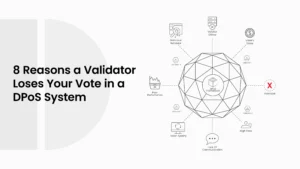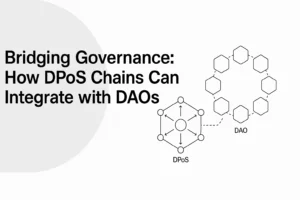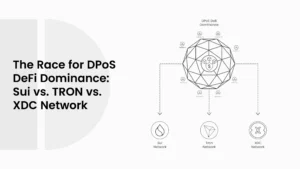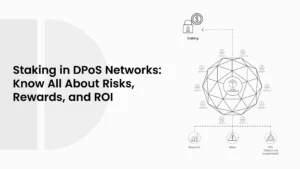The Future of Validator Nodes in DPoS: Hardware, Geography, and Centralization
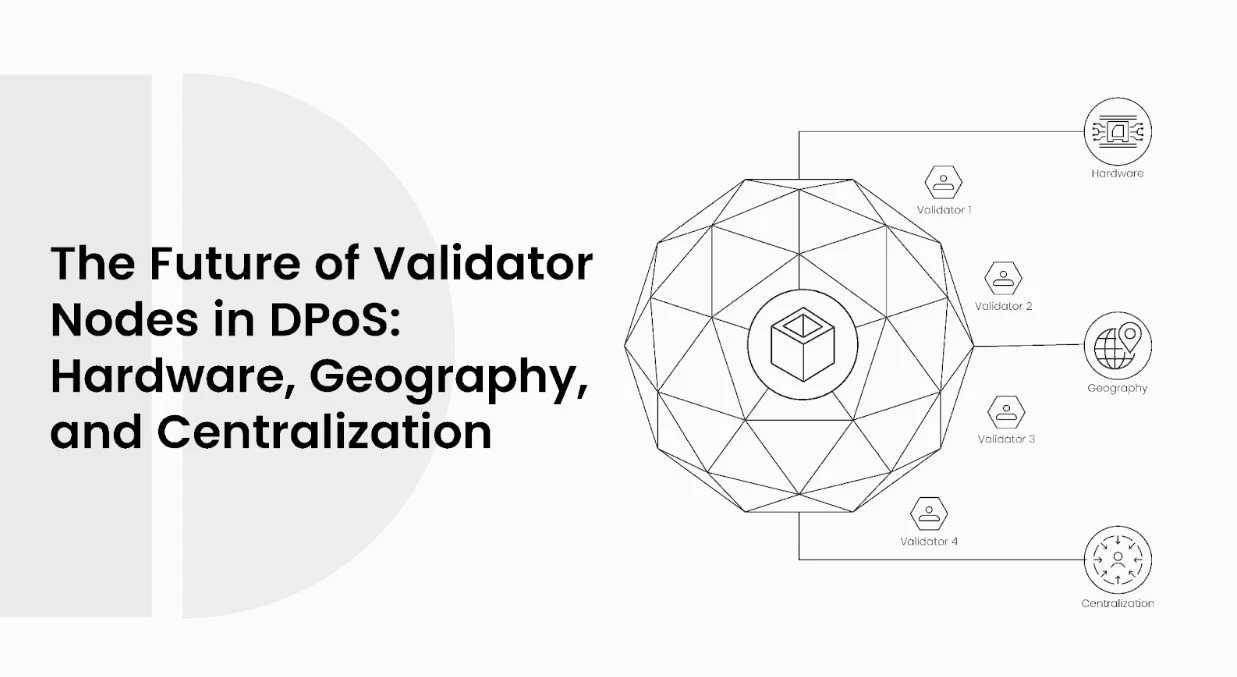
Validator nodes are the heart of Delegated Proof of Stake, also called DPoS. They are the machines that check and approve the blocks that are added to the blockchain. Without validator nodes, the whole system would stop working.
- What Are Validator Nodes in DPoS?
- Hardware Needs for Validator Nodes
- How Hardware Shapes Node Performance
- The Shift from Home Computers to Data Centers
- Cost of Running a Validator Node
- Geography of Validator Nodes
- Why Location Matters in Decentralization
- Regional Hotspots for Validators
- Hosting Providers and Cloud Dependence
- Hosting Providers and Geography
- Centralization Problems in DPoS
- Token Distribution and Voting Power
- Foundation and Developer Control
- Centralization Theater
- Centralization Risks Table
- Future of Validator Hardware
- Will There Be Special Validator Machines?
- Edge Computing and Local Validators
- Cost vs Security
- Future of Validator Geography
- Push for Global Spread
- Risks of Data Center Concentration
- Geographic Balance Examples
- Future of Centralization in DPoS
- Can DPoS Stay Truly Decentralized?
- New Models to Fight Centralization
- The Two-Axis Model Explained Simply
- Case Studies of Validator Node Trends
- Cosmos Ecosystem
- EOS and TRON
- Smaller Blockchains
- Looking Ahead: What Will Validator Nodes Look Like in 2030?
- Conclusion
- Frequently Asked Questions About The Future of Validator Nodes in DPoS
- What is a validator node in DPoS?
- Why does validator location matter in blockchain?
- Can validator nodes run on normal computers?
- How much does it cost to run a validator node?
- Is DPoS better than Proof of Work for decentralization?
- Glossary of Key Terms
Today, many blockchains use DPoS because it is fast and allows people to vote for who should run the network. This system sounds simple, but the future of validator nodes is not so simple. Hardware, geography, and centralization are three big issues that will decide how safe and strong these blockchains will be in the coming years.
This blog will talk about what validator nodes are, why their hardware is important, how geography changes the game, and why centralization is always a risk. The goal is to make it easy to understand. Even if you are not a technical person, by the end, you will know how validator nodes shape the future of DPoS.
ALSO READ: Learning from Failures: Post-Mortems of Abandoned DPoS Projects
What Are Validator Nodes in DPoS?
A validator node is just a computer, but it is a special one. It is not used for playing games or watching movies. It is used for checking blockchain transactions. Every time someone sends tokens on a DPoS chain, a validator node makes sure the transaction is correct and adds it to the chain.
In DPoS, not everyone can be a validator. Token holders vote for a small group of validators. This group then produces the blocks and secures the chain. People who do not run a validator are called delegators. They can still take part by staking their tokens with the validator they trust.
The reason validator nodes matter so much is that they control the health of the blockchain. If they work well, the network is fast and safe. If they fail or if too few people control them, the network becomes weak.
Hardware Needs for Validator Nodes
How Hardware Shapes Node Performance
The hardware behind a validator node is like the engine of a car. A weak engine makes the car slow. A strong engine makes it run smoothly. Validator nodes need powerful CPUs, enough RAM, strong storage, and very good internet speed.
If the hardware is weak, the validator can miss blocks. That means the network slows down and people lose trust. If the hardware is strong, the node can handle many transactions at once. This makes the blockchain reliable.
The Shift from Home Computers to Data Centers
In the early days, people could run validator nodes on normal home computers. Some even did it from laptops or old desktops. But today things have changed. Modern blockchains have high traffic, and they need validators to use servers that are fast and always online.
Because of this, many validators moved from home setups to professional data centers or cloud providers like AWS, Google Cloud, and Hetzner. This gives stability, but it also raises questions. If too many validators use the same few data centers, is it still decentralized?
The future may push this trend even more. Nodes may need specialized machines that cost thousands of dollars. That makes it harder for normal people to run them and may increase centralization.
Cost of Running a Validator Node
Here is a simple table showing the cost difference between a home setup and a professional setup.
| Setup Type | Hardware Cost | Internet Cost (monthly) | Maintenance | Reliability |
| Home Computer | $800 – $1,200 | $50 – $100 | Low | Medium |
| Small Server | $2,000 – $3,000 | $100 – $200 | Medium | High |
| Data Center Cloud | $4,000+ | $200 – $400 | High | Very High |
As the table shows, the more reliable the validator node, the more money it costs. This is why many people worry that validator roles are moving away from normal users to companies that can afford these costs.
Geography of Validator Nodes
Why Location Matters in Decentralization
The location of validator nodes is very important for the health of a blockchain. If most of the validators are in one country or even in one city, then the network is at risk. A local power outage, a government rule, or even a natural disaster can bring the network down.
When nodes are spread out across many countries and continents, the system is harder to attack. Even if one area goes offline, the blockchain will still work because other nodes are alive in other places. That is why many projects try to push for wide distribution.
Regional Hotspots for Validators
Today, many validator nodes are found in North America, Europe, and some parts of Asia. These regions have good internet, cheap electricity in some cases, and strong data centers. But other areas like Africa, South America, and smaller island nations often have very few validators.
This uneven spread makes the blockchain weaker. If 70% of the validators sit in Europe and North America, then the power to control the chain is also sitting there. That means less real decentralization, even if the blockchain says it is open to everyone.
Hosting Providers and Cloud Dependence
Another big issue is cloud hosting. Many validators do not own their own machines. They rent servers from big companies like AWS, Google Cloud, or Hetzner. This is easier but risky. If these providers decide to shut down accounts, many nodes would disappear at the same time.
This shows that even if validators are spread across countries, they can still be too dependent on a few hosting companies. True decentralization means not only spread by geography but also spread by provider.
ALSO READ: Why Delegated Proof of Stake (DPoS) Appeals to Smaller Blockchains
Hosting Providers and Geography
Here is a simple look at where validators often run their machines:
| Region | Main Countries | Popular Hosting Providers | Risk Level if Concentrated |
| North America | USA, Canada | AWS, Google Cloud | High if over 40% here |
| Europe | Germany, UK, France | Hetzner, OVH, Azure | High if providers dominate |
| Asia | Singapore, Japan, South Korea | Local ISPs, Alibaba Cloud | Medium to High |
| South America | Brazil, Argentina | Small data centers | Medium |
| Africa | Nigeria, South Africa | Limited providers | Medium to Low but fewer nodes |
This table shows that while North America and Europe lead, they also carry the biggest risk of centralization if too many validators gather there. Future blockchains must think about this when building their networks.
Centralization Problems in DPoS
Token Distribution and Voting Power
In DPoS, the power to choose validators comes from tokens. People who own more tokens have more votes. If only a few wallets hold most of the tokens, then those few people can control who becomes a validator.
This is a problem because it makes the network less open. Instead of many small users having a say, only a handful of big players decide the future. Even if the blockchain has hundreds of validators, the truth is the vote is in the hands of the rich wallets.
Foundation and Developer Control
Many blockchains have a foundation or a developer team that holds a large amount of tokens. They say it is for supporting the network. But in real life, it often gives them power to push validators in or out.
This means decentralization is not as strong as people think. Even if validators are in different countries, the decision-making is in the hands of one group. This is a form of hidden centralization.
Centralization Theater
Some people call this “centralization theater.” It means the network looks decentralized on paper, but in practice, it is controlled by a small group. For example, a chain may say it has 100 validators, but if 5 wallets control 70% of the vote, then those 5 are the real power.
This is dangerous because it makes the system easy to capture. If those few actors make bad decisions, the whole chain suffers. And because it looks decentralized from the outside, many users may not even notice until problems happen.
Centralization Risks Table
Here is a table that shows how different types of centralization affect DPoS:
| Type of Centralization | How It Happens | Risk for the Network | Example Outcome |
| Token Concentration | Few wallets own most tokens | Voting power is in a few hands | Same validators always win |
| Foundation Control | The Foundation delegates a large stake | Developers can control decisions | Validators forced in or out |
| Cloud Hosting Control | Too many nodes on the same provider | A single company can shut down nodes | Service outage |
| Regional Clustering | Most validators in the same country | Local laws or disasters impact all | Network downtime |
The table shows that centralization is not only about tokens. It can come from hosting, geography, or even organizations that hold power. A real decentralized system must fight all of these risks, not just one.
Future of Validator Hardware
Will There Be Special Validator Machines?
Currently, most validators utilize standard servers that can be purchased or rented. But as blockchains grow bigger, many people may see machines built only for validation. These could be like mining rigs in Proof of Work, but instead made for DPoS.
The risk with this is cost. Special validator hardware could be very expensive. If the price is too high, then only rich companies can run them. That means fewer people join, and centralization becomes worse. On the other hand, special machines may make the network more secure and faster. So there is always a trade-off.
Edge Computing and Local Validators
Another trend could be edge computing. This means validators run close to the people who use the blockchain. Instead of all validators sitting in big data centers, they could be smaller machines spread across cities and regions.
This can lower the delay in transactions and give faster confirmation. It can also help with decentralization because nodes are no longer stuck in a few big cloud providers. But this will need a strong internet connection and good support from projects to make it work.
Cost vs Security
Running a validator will always balance cost and security. Cheaper hardware makes it easy for more people to join, but it may fail under heavy traffic. Stronger hardware makes the network fast and safe, but it also locks out small players.
ALSO READ: Bridging Governance: How DPoS Chains Can Integrate with DAOs
Here is a simple comparison:
| Hardware Level | Setup Example | Cost (Yearly) | Security Level | Who Can Join |
| Low | Home PC + Good Internet | $1,000 – $2,000 | Low | Small hobbyists |
| Medium | Small Data Center Server | $5,000 – $10,000 | Medium | Tech groups, startups |
| High | Specialized Validator Rig | $20,000+ | High | Large firms, pro validators |
This shows the hard choice in the future. If blockchains demand high-end machines, then decentralization will suffer. If they stay open to small setups, then speed and safety may not be enough. The right balance will decide the future of validator hardware.
Future of Validator Geography
Push for Global Spread
For DPoS to be strong, validator nodes must be spread across the world. If they are only in a few regions, then the system can fail when that region faces problems. Many projects already know this, so they give rewards or incentives for validators who run in new locations.
In the future, everyone may see more programs that push for validators in Africa, South America, and smaller regions. This will not be simple, because these areas sometimes have weaker internet or higher costs. But if done right, it will make blockchains harder to attack.
Risks of Data Center Concentration
Even if validators are in different countries, the truth is that many of them still run on the same cloud companies. This is a big risk. If AWS, Google Cloud, or Hetzner all host most of the validators, then the network is not really free. It is dependent on these companies.
In the future, everyone may see rules from projects that force validators to use different providers. Or people may see more validators move to private bare metal servers. This change would make the system safer, but it will cost more too.
Geographic Balance Examples
The future may also bring better tools for checking where validators are. Right now, some networks do not share enough details about node locations. If this changes, communities can track the balance better and push for more spread.
Here is a simple table to show how two blockchains could look:
| Network Example | Node Spread | Hosting Type | Risk Level | Notes |
| Chain A | 70% in Europe, 20% in USA, 10% Asia | Mostly Hetzner + AWS | High Risk | Strong but not diverse |
| Chain B | 25% USA, 25% Europe, 25% Asia, 15% South America, 10% Africa | Mix of cloud + bare metal | Low Risk | More balanced and safer |
This shows that it is not only about how many validators exist. Where they are, and who hosts them, also decide the strength of decentralization.
Future of Centralization in DPoS
Can DPoS Stay Truly Decentralized?
This is the big question. DPoS was made to be more open and democratic than Proof of Work. But in practice, it often becomes controlled by a few big players. In the future, this risk may grow even more.
If hardware costs rise and tokens stay in the hands of big investors, then normal users will find it hard to join. This means the dream of decentralization may not be real. The system can look free, but in truth, only a few decide.
New Models to Fight Centralization
Some projects are already thinking of new rules to fight this. One idea is rotating validators. That means not the same validators always win, but new ones get a chance every cycle. Another idea is to put limits on how much stake one validator can get.
There are also reward systems that give bonuses to smaller validators, so they can compete with the big ones. These models are still being tested, but they may shape the future of DPoS if they work.
The Two-Axis Model Explained Simply
Experts often talk about decentralization in two ways. The first is network topology. This means where the validators are, what hardware they use, and how spread out they are across the world.
The second is governance topology. This means who holds the voting power, how many people take part in the votes, and if foundations or small groups control decisions.
Both must be balanced. If you only fix the network side but let one group own all the tokens, then you still have centralization. If you spread tokens, but all validators are on the same cloud provider, that is also centralization. True DPoS needs both sides to be strong.
Case Studies of Validator Node Trends
Cosmos Ecosystem
Cosmos is often seen as a good example of DPoS in action. It has many chains connected with each other, and each chain has its own set of validators. The good side is that validators are spread across many countries. This gives Cosmos some strength in geography.
But still, token distribution is not perfect. Some foundations and big wallets hold a lot of voting power. This means that even though the nodes are spread out, the decision-making is still in the hands of a smaller group. It shows that geography alone is not enough if governance is centralized.
EOS and TRON
EOS was once one of the biggest names in DPoS. It promised high speed and strong decentralization. But in practice, it faced big issues. Many times, the same validators kept winning because of vote buying and concentration of tokens. This made people question whether EOS was really decentralized.
TRON had a similar story. It grew fast and had many validators, but control was often seen in the hands of a few. The community called this “cartel behavior,” where validators work together to keep power. These lessons show that just having validators does not guarantee fairness.
Smaller Blockchains
Smaller DPoS blockchains face a different problem. They often do not have enough validators at all. Some networks run with only a few dozen nodes, and many of those are in the same region or even the same hosting company.
This makes them weak to attacks or failures. But at the same time, small chains sometimes experiment with new models, like rotating validators or giving extra rewards to new nodes. These tests may help bigger chains in the future if they succeed.
ALSO READ: Hybrid Governance Models: Blending DPoS with Traditional PoS
Looking Ahead: What Will Validator Nodes Look Like in 2030?
Validator nodes will not look the same in 2030 as they do now. The growth of blockchains will push hardware, geography, and governance in new directions.
One possible future is stronger and smarter machines. Validators may use AI tools to predict network load or detect attacks before they happen. These machines may be costly, but they also make the system more secure.
Another future trend is a wider global spread. More countries will host validators as the internet and technology improve. Africa, South America, and smaller regions may get more active. This can lower the risks of too much power in North America and Europe.
But there are also dangers. If most validators stay inside big data centers or cloud providers, then the centralization risk will not go away. It may even get worse. Also, if staking tokens stay concentrated with a few big players, then governance will not be fair.
The truth is, validator nodes in 2030 will decide how trusted DPoS really is. If networks can balance cost, location, and voting power, they will be safe and strong. If not, they may face the same problems of centralization that people see today.
Conclusion
Validator nodes are the heart of DPoS. They are the computers that keep the chain alive. The future of validator nodes will depend on three things: hardware, geography, and centralization.
Hardware will get stronger, but also more costly. Geography will get wider, but the risks of too much power in data centers will still be there. Centralization will always be the hardest problem, because tokens and power often sit in the hands of a few.
If DPoS networks find a balance between these three, then they will stay safe, fast, and open. If they fail, then decentralization will be only a word, not a reality. The next years will show which way DPoS will go.
Frequently Asked Questions About The Future of Validator Nodes in DPoS
-
What is a validator node in DPoS?
A validator node is a computer that checks transactions and adds new blocks to the blockchain. In DPoS, token holders vote for validators, and these validators keep the chain safe.
-
Why does validator location matter in blockchain?
If all validators are in one region, the chain can stop working if that region has power cuts, laws, or disasters. Spreading them across the world makes the network stronger.
-
Can validator nodes run on normal computers?
In the past yes, but now it is very hard. Modern blockchains need servers with strong CPUs, lots of RAM, and high internet speed. Small home computers usually cannot handle it.
-
How much does it cost to run a validator node?
It depends. A small home setup can cost around $1,000–$2,000 a year. A data center setup can cost $10,000 or more. Some professional setups even go above $20,000 per year.
-
Is DPoS better than Proof of Work for decentralization?
DPoS is faster and uses less energy than Proof of Work. But it can be less decentralized, because voting power is often in the hands of a few big wallets or foundations.
Glossary of Key Terms
- Validator Node: A computer that checks blockchain transactions.
- Delegator: A person who stakes tokens with a validator.
- Staking: Locking tokens to support validators and earn rewards.
- Governance: The way decisions are made on the blockchain.
- Decentralization: Power spread across many people or machines.
- Centralization Theater: When a system looks decentralized but is still controlled by a small group.

